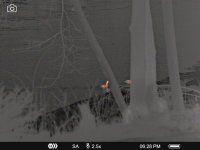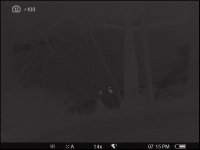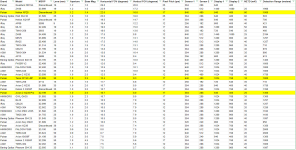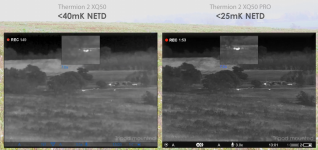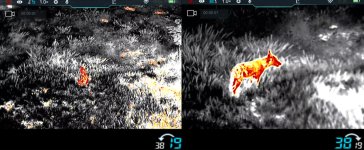-
Welcome to BirdForum, the internet's largest birding community with thousands of members from all over the world. The forums are dedicated to wild birds, birding, binoculars and equipment and all that goes with it.
Please register for an account to take part in the discussions in the forum, post your pictures in the gallery and more.
You are using an out of date browser. It may not display this or other websites correctly.
You should upgrade or use an alternative browser.
You should upgrade or use an alternative browser.
Night vision equipment for mortals (3 Viewers)
- Thread starter jurek
- Start date
More options
Who Replied?Vollmeise
Well-known member
The XP50 is a great and versatile tool due to it's interchangeable lenses.went out with the thermal today for more testing, found a lifer for me which was a long eared owl
no way I would've been able to see this guy without the thermal. even once I knew where he was roughly, it was difficult to get between all the branches
I definitely could've benefitted from something with a wider FOV though. not sure how to calculate what this telos is, but I imagine 2x or 1.5x mag would be nice for close quarters in pines
Try to get a 38 or 28mm lens on the used market to get the wider FOV You talked about. A shame that Pulsar didn't follow that unique feature and discontinued selling lenses for their Helion XP series.
Cheers)
yes, I believe it automatically recalibrates every minute or so during use.could be a silly question, but did you recalibrate it?
at least on my Pulsar, there's a way to manually calibrate and I have to do that a couple times during use if conditions change, IE if I leave it inside the heated car and then want to use it outside. something like that could have affected it
nmerc_photos
Member

The XP50 is a great and versatile tool due to it's interchangeable lenses.
Try to get a 38 or 28mm lens on the used market to get the wider FOV You talked about. A shame that Pulsar didn't follow that unique feature and discontinued selling lenses for their Helion XP series.
Cheers)
we are talking about different XP50's. I have the newest Telos, you are talking about the Helion. as of right now, the Telos doesn't offer any interchangeable lenses
I paid around $4200 USD for my Telos XP50. I just bought a discontinued Helion XP28 for $2000 USD on facebook.
My buddy and I went out owling this morning. I had the XP28, gave my buddy the XP50.
We ended up finding 2 barred owls and 2 screech owls. All 4 were seen by me first (wide POV), but he could get more detail (higher mag).
I could walk around and scan just left-to-right, while he had to scan left-to-right in addition to up-and-down due to the small FOV.
For me, there is no contest. Wide FOV seems to be the most important aspect of a thermal for birding. We switched thermals halfway through the morning and I was frustrated with how tight the POV was on the doubly as expensive XP50.
Strongly considering selling the XP50 for an iRay ZH38, but not sure I want to run 1 Pulsar and 1 iRay. Definitely never gonna sell the XP28.
The XP50 would be useful somewhere wide open like Yellowstone, but I don't think it's of much value locally in tight Michigan woods.
I'll get some pics up later today probably.
additionally, I've got a lot of friends interested in trying out thermals - but are understandably scared by the price. my new goal is to find something sub $2K that would work well... and is available new. seems Pulsar no longer offers wide FOV options new, so the only hope there is to buy used and discontinued.. which has its own risks. here is a list I've compiled from different forums. since I think FOV is the most important, I have filtered that way with best ones at top, and worst at bottom.
Attachments
Last edited:
I have the XM22, which is low down in that list, and I quickly found it a pain panning left /right and vertically too.
So I use it sideways, "portrait mode", that way, just a single sweep left to right tends to cover the entire area.
I wouldn't say "no" to a greater field of view, but the subjects tend to be a fair distance away, and fairly stationary. It doesn't feel like too much of a disadvantage. I don't feel as though I'm missing anything, just longer sweeps!
So I use it sideways, "portrait mode", that way, just a single sweep left to right tends to cover the entire area.
I wouldn't say "no" to a greater field of view, but the subjects tend to be a fair distance away, and fairly stationary. It doesn't feel like too much of a disadvantage. I don't feel as though I'm missing anything, just longer sweeps!
nmerc_photos
Member

holding it in portrait mode is an excellent idea! I hadn't considered that. we'll give it a try during our next outingI have the XM22, which is low down in that list, and I quickly found it a pain panning left /right and vertically too.
So I use it sideways, "portrait mode", that way, just a single sweep left to right tends to cover the entire area.
I wouldn't say "no" to a greater field of view, but the subjects tend to be a fair distance away, and fairly stationary. It doesn't feel like too much of a disadvantage. I don't feel as though I'm missing anything, just longer sweeps!
I find that if you have enough time and are stationary, yes a small FOV can work as well. but if you're trying to cover large distances (hiking) or viewing out a car window, the large FOV is worth its weight in gold.
also with a narrow FOV, you have to make sure that you're thorough with your sweeps. it's very easy to miss a certain area because you forgot to go up down, or left right. with wide FOV you just get it all at once.
as a frame of reference, here are two pictures taken on the river (30 seconds apart despite the time difference - I need to update the XP28)
2.5 mag vs 1.4 mag - Telos XP 50 vs Helion XP28
Attachments
Farnboro John
Well-known member
Took my new Guide TD210 down to the New Forest last night for a bit of a test. Unfortunately the car park I'd selected as being the most likely for an array of nocturnal mammals turned out to be the local dogging site - not so likely after all!
I moved to another car park down the same road and was left in peace for about three hours, when a small car with a noisy exhaust came in and stopped for about five minutes. I think their nerve broke before mine and after two or three attempts to start the car they got it going and left revvily.
Anyway, to the business of the night.
I wasn't in car park 1 for very long after it got truly dark but while people were still returning to their cars I detected dogs off lead. Later I detected two small mammals at about fifteen yards and tracked them from a picnic table to a heap of logs and back again easily. At car park 2 it was Wood Mouse city! I found several along the line of a ditch bordering the car park and tracked them effortlessly. When one paused near me I got the camera out and found the mouse (identified from behaviour, no way to do it using the thermal imager, no detail - can't even see mouse tails) was too jumpy for even red or green light. However, I did get a brief view bare-eyed in the red light confirming the ID. Later I got out of the car and did manage to get a few pictures of mice that presumably felt so safe in their positions huddled up to tree roots or whatever that they froze rather than running. Red or green light still didn't seem to matter. I didn't bother trying white light, I was sure they'd leg it.
So the device is good for finding stuff but you'll need a different system to identify it.
John
I moved to another car park down the same road and was left in peace for about three hours, when a small car with a noisy exhaust came in and stopped for about five minutes. I think their nerve broke before mine and after two or three attempts to start the car they got it going and left revvily.
Anyway, to the business of the night.
I wasn't in car park 1 for very long after it got truly dark but while people were still returning to their cars I detected dogs off lead. Later I detected two small mammals at about fifteen yards and tracked them from a picnic table to a heap of logs and back again easily. At car park 2 it was Wood Mouse city! I found several along the line of a ditch bordering the car park and tracked them effortlessly. When one paused near me I got the camera out and found the mouse (identified from behaviour, no way to do it using the thermal imager, no detail - can't even see mouse tails) was too jumpy for even red or green light. However, I did get a brief view bare-eyed in the red light confirming the ID. Later I got out of the car and did manage to get a few pictures of mice that presumably felt so safe in their positions huddled up to tree roots or whatever that they froze rather than running. Red or green light still didn't seem to matter. I didn't bother trying white light, I was sure they'd leg it.
So the device is good for finding stuff but you'll need a different system to identify it.
John
nmerc_photos
Member

I have been doing a lot of research on the ZH38. I think if I were to start fresh, knowing what I know now - that would be my #1 pick on paper.There is a "zoom" model with dual focal lengths now, InfiRay ZH38. Does that sound like the answer?
With the 19mm focal length selected, it is 22.9 x 17.2 FOV, 12µm pixel pitch, 640x512 sensor and 1440x1080p display. All very good specs.
You can also "zoom" it optically to the 38mm, which gives it very close specs to my current Telos XP50. Meaning you'd have one wide angle option and one closer option if you were somewhere that could utilize a narrow FOV.
My only hesitations is that it is the only thermal of its kind. Everything in life is a trade off, so I'm not yet sure what they sacrificed to be able to get the optical zoom capability. Also in the comparison videos I've seen, it seems that iRay's top stuff isn't quite on the quality level of Pulsar. Having owned and used a few Pulsar products, I can say that the image quality is outstanding (even on a 10 year old model) and the button layouts are intuitive and have been kept essentially the same over time.
Last edited:
Yes, I'm fortunate in that the only Bat survey I do, where I use the Thermal device in conjunction with bat detector and torch, is for Daubenten's bat.holding it in portrait mode is an excellent idea! I hadn't considered that. we'll give it a try during our next outing
I find that if you have enough time and are stationary, yes a small FOV can work as well. but if you're trying to cover large distances (hiking) or viewing out a car window, the large FOV is worth its weight in gold.
also with a narrow FOV, you have to make sure that you're thorough with your sweeps. it's very easy to miss a certain area because you forgot to go up down, or left right. with wide FOV you just get it all at once.
as a frame of reference, here are two pictures taken on the river (30 seconds apart despite the time difference - I need to update the XP28)
2.5 mag vs 1.4 mag - Telos XP 50 vs Helion XP28
They move very predictably just above the water's surface along rivers, so effectively in 1 dimension only! As long as it covers the width of the river, then its catching every passing bat.
If I was looking at a church or trees, then the wider field of view would be essential.
nmerc_photos
Member

as I've continued down the rabbit hole of specs and brand options, my spreadsheet has grown a bit.
if anyone has any other models they'd like to suggest - please do so
the 3 highlighted ones are either ones I own, or the one my buddy purchased that I will be testing soon
I'm still sorting by FOV, as I think it is the most important aspect - but I may try to build a formula that takes into account FOV, price, NETD, etc. to determine "best value".
I think the ZH38 is the best overall (if price is no object) because you can utilize the extremely wide FOV, but still also have the significant detection range (~2200m)
if anyone has input on how to weight different values (NETD, FOV, etc.) please let me know...there are some cheap ones on here with wide FOV, but I wonder how limiting their NETD or sensor resolutions would be
if anyone has any other models they'd like to suggest - please do so
the 3 highlighted ones are either ones I own, or the one my buddy purchased that I will be testing soon
I'm still sorting by FOV, as I think it is the most important aspect - but I may try to build a formula that takes into account FOV, price, NETD, etc. to determine "best value".
I think the ZH38 is the best overall (if price is no object) because you can utilize the extremely wide FOV, but still also have the significant detection range (~2200m)
if anyone has input on how to weight different values (NETD, FOV, etc.) please let me know...there are some cheap ones on here with wide FOV, but I wonder how limiting their NETD or sensor resolutions would be
Attachments
Last edited:
nmerc_photos
Member

tenex
reality-based
For some reason ZH38 has unimpressive sensitivity of 50mK when other similarly expensive units go down to 20. Is it known how this affects range or detail rendition?if anyone has input on how to weight different values (NETD, FOV, etc.) please let me know...
nmerc_photos
Member

Hmm I have it in my notes as <25mK. but now that I look at multiple sites, I see both.For some reason ZH38 has unimpressive sensitivity of 50mK when other similarly expensive units go down to 20. Is it known how this affects range or detail rendition?
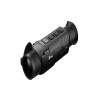
Thermal Imaging Monocular ZOOM ZH38 Manufacturer
Searching for Thermal Imaging Monocular ZOOM ZH38? InfiRay Technologies offers wide range of thermal night vision for you choose.
www.infirayoutdoor.com
^25mK
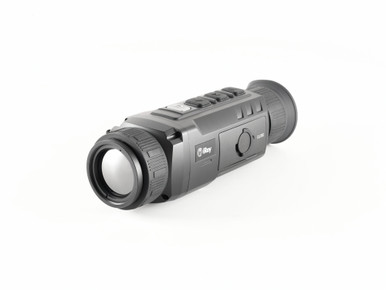
ZOOM ZH38 Dual FOV 640x512 19-38MM 1X/2X Thermal Monocular
The ZOOM ZH38 is not only the world’s first dual FOV handheld thermal imager available in the commercial market, but also the first handheld product to feature Shutterless Calibration Technology (SCT) simplifying use and reduce power consumption.
 irayusa.com
irayusa.com
^50mK
I would imagine 25 is the correct number, as that price for a 50 mk unit would be a little insane. But maybe that is the sacrifice they had to make, that I mention above?
NETD makes a big difference. attached pic shows 2 Pulsar models that are almost exactly the same outside of NETD
Attachments
tenex
reality-based
Thanks, I'd only seen the second of those pages. I agree that 25mK seems more likely than 50. But wondering about "sacrifice"... I'm bothered by this image from the brochure. The 38mm image on the right doesn't really seem to have the same resolution as the 19mm on the left.
Attachments
Lens focal length and pixel size determine the resolution (detail) you’ll see. The sensitivity depends on the pixel size, the lower ones seem to use the 17micron sensors, the higher the newer/smaller 12micron. I’d go for around 3x optical and the most pixels, so you don’t compromise detail too much and you get as wide a field as you can. Going with higher mag with larger sensors. Digital zoom gets bad very fast, so I rarely touch it. Dual lens is an interesting option, have to see how it works in practice.
Peter
Peter
nmerc_photos
Member

to my eye, they both look about similarThanks, I'd only seen the second of those pages. I agree that 25mK seems more likely than 50. But wondering about "sacrifice"... I'm bothered by this image from the brochure. The 38mm image on the right doesn't really seem to have the same resolution as the 19mm on the left.
that being said, a friend of mine just bought a new ZH38 for around $3200 USD, so once he gets it in we'll do testing with it and compare to the 3 pulsar models I have access to
I have another friend who will probably purchase an AGM TM10-256 for around $500 USD, and I myself may try to grab an AGM TM15-384 for around $1000 USD to test. I think these two models will be the best budget option for a birder.
Vollmeise
Well-known member
Well, I could compare an Infiray ZH38 vs my Pulsar Helion XP50 (and its 28mm interchangeable lens) side by side.
The Infiray's viewfinder seemed even worse than my Pulsar's when wearing glasses.
The image itself was ok, with some visible resolution falloff and vignetting towards the edges.
The ZH38's "zoom" lens is a very unique thing to be used by turning its focus ring only.
When in wide angle position, you have to turn the image out of focus and keep turning, turn, turn... until the image gets in focus again, but with the 38mm field of view now.
So, it is helpfull indeed, but a bit awkward to use.
Cheers)
The Infiray's viewfinder seemed even worse than my Pulsar's when wearing glasses.
The image itself was ok, with some visible resolution falloff and vignetting towards the edges.
The ZH38's "zoom" lens is a very unique thing to be used by turning its focus ring only.
When in wide angle position, you have to turn the image out of focus and keep turning, turn, turn... until the image gets in focus again, but with the 38mm field of view now.
So, it is helpfull indeed, but a bit awkward to use.
Cheers)
nmerc_photos
Member

Well, I could compare an Infiray ZH38 vs my Pulsar Helion XP50 (and its 28mm interchangeable lens) side by side.
The Infiray's viewfinder seemed even worse than my Pulsar's when wearing glasses.
The image itself was ok, with some visible resolution falloff and vignetting towards the edges.
The ZH38's "zoom" lens is a very unique thing to be used by turning its focus ring only.
When in wide angle position, you have to turn the image out of focus and keep turning, turn, turn... until the image gets in focus again, but with the 38mm field of view now.
So, it is helpfull indeed, but a bit awkward to use.
Cheers)
this is quite interesting feedback, thank you! The Helion XP28 you are referencing is quite ancient, 5-10 years old, no?
I find it to be noticeably worse than my new Telos XP50, so for the iRay to appear worse than the XP28 doesn't bode well. I wonder how much of it is the issue of eye piece and using glasses.
Do you generally prefer the ZH38 or the XP28?
in other news I bought an AGM TM10-256 for $465 USD, so I will soon have that to compare to the more expensive models and see if it is worth purchasing as a birder on a budget
Users who are viewing this thread
Total: 4 (members: 0, guests: 4)







